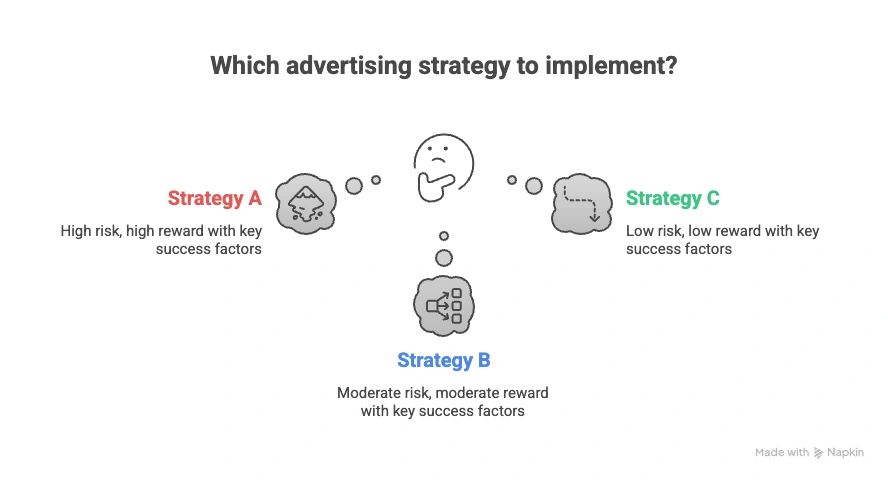What American Eagle, Doja Cat, and Tootsie Pop Teach Us About Advertising in 2025
.webp)
Listen to the podcast version here:
I. Introduction: Advertising at a Crossroads
Advertising in 2025 looks different from the polished, predictable campaigns of the past decade. Audiences are harder to impress, cultural conversations move at lightning speed, and safe creative often fails to stand out. To capture attention, brands are experimenting with bigger creative swings, sometimes sparking controversy, sometimes generating viral stunts, and sometimes leaning on nostalgia to reconnect with audiences.
Three recent campaigns highlight this trend:
- American Eagle’s “Great Jeans” ad with Sydney Sweeney, which began as a playful pun but quickly drew public debate.
- Doja Cat’s lipstick stunt at the VMAs for MAC Cosmetics, where she appeared to eat a tube of lipstick, later revealed to be a chocolate creation by chef Amaury Guichon .
- Tootsie Pop’s reboot of its “How Many Licks” commercial, a refreshed take on a 50-year-old ad.
Each campaign used a distinct strategy, controversy, virality, and nostalgia, yet all earned cultural attention. Together, they illustrate how brands are adapting to today’s fast-changing advertising environment.
.webp)
II. Lesson 1: Controversy and Its Risks (American Eagle x Sydney Sweeney)
The American Eagle “Great Jeans” campaign featuring Sydney Sweeney launched in July 2025. The ad played on the dual meaning of jeans and genes, suggesting Sweeney was “born to wear great denim.” While intended as lighthearted wordplay, the campaign was interpreted differently by audiences.
Commentary online raised concerns that the language echoed ideas of genetic superiority, while others questioned whether the focus was more on the celebrity than on the product itself.
Initially, the ad drove visibility, with searches for “American Eagle ad” spiking and the company’s stock price rising nearly 20% after high-profile endorsements (New York Post). However, momentum shifted quickly. Within weeks, foot traffic to stores dropped almost 9%, according to Retail Brew.
This case highlights the dual nature of controversial advertising: while it can generate significant short-term attention, it can also carry reputational and business risks if interpretations diverge from intended messaging.
III. Lesson 2: Virality Through Stunts (Doja Cat x MAC Lipstick Stunt)
At the 2025 MTV Video Music Awards, Doja Cat gained attention by applying a tube of lipstick on the red carpet and then appearing to eat it.
Later, MAC Cosmetics confirmed the lipstick was an edible chocolate replica of Doja Cat’s signature shade, Lady Danger, crafted by pastry chef Amaury Guichon (People). The moment also served as the official reveal of Doja Cat as a Global Ambassador for the brand.
The stunt worked across several dimensions:
- Visual impact: The act was unusual enough to spark instant curiosity.
- Cultural fit: Doja Cat’s unconventional persona aligned with the brand’s reputation for artistry and experimentation.
- Amplification: Within hours, the moment was trending across platforms, extending the campaign’s reach.
Industry commentary suggested this type of approach reflects how endorsements are evolving. As one strategist noted, “How you do these brand placements now is so important” (The Times).
The example illustrates how stunt marketing can succeed when it feels consistent with both the brand and the talent involved.
IV. Lesson 3: Nostalgia as Connection (Tootsie Pop’s “How Many Licks” Reboot)
In September 2025, Tootsie Pop released an updated version of its iconic “How Many Licks” commercial. Originally launched in 1969, the ad is considered one of the longest-running in U.S. television history.
Watch the 2025 ad here:
The refreshed campaign kept the original storyline of a boy asking Mr. Owl how many licks it takes to reach the center of a Tootsie Pop, while updating the animation, sound design, and character details for modern audiences (Today).
Reception to the update highlighted three key strengths:
- Shared memory: The ad appealed to multiple generations who grew up with the original.
- Modern design: Upgraded visuals made it more suitable for digital platforms.
- Strategic timing: The release aligned with Halloween candy season.
Executives emphasized the balance of heritage and modernization. “Nostalgia continues to be a driving force in today’s culture, and few characters are as iconic and fun as Mr. Owl,” said Tootsie Roll Industries’ COO (NBC News).
This case underscores how nostalgic campaigns can strengthen brand equity when updated thoughtfully.
Watch the classic Tootsie Pop ad here:
V. Comparing the Three Campaigns: A New Playbook for 2025
Viewed together, the three campaigns illustrate distinct approaches to gaining attention in 2025:
- American Eagle (Controversy): Generated awareness but faced challenges in perception and brand alignment .
- Doja Cat x MAC (Virality): Leveraged a stunt to create a cultural moment and extend brand reach .
- Tootsie Pop (Nostalgia): Revived a cultural touchstone to connect with multiple generations .
The Emerging Playbook
Advertising in 2025 shows that safe, formulaic campaigns often struggle to stand out. Instead, brands are experimenting with three distinct strategies:
- Controversy — provokes conversation but carries higher reputational risk.
- Virality — thrives on spectacle but depends on authenticity.
- Nostalgia — offers familiarity but requires modernization to stay relevant.

The role of creative analytics is central. As highlighted in the AdSkate analysis of American Eagle, pre-testing creative can help identify risks, while real-time sentiment tracking can guide mid-campaign adjustments.
VI. Conclusion: What Brands Should Learn
The advertising landscape of 2025 demonstrates the variety of strategies available for capturing attention.
- Controversy can generate visibility but may create unintended challenges if not tested across diverse audiences.
- Stunt-driven virality can spark cultural conversation when aligned with brand and talent identity.
- Nostalgia remains a reliable way to connect across generations when balanced with modern execution.
For marketers, the key takeaway is that there is no single path to success. Each strategy offers potential benefits and risks. What unites them is the importance of data-driven creative testing to anticipate reactions and adapt as needed.
These campaigns reflect how advertising continues to evolve, less about universal approval, and more about creating moments that resonate, whether through debate, surprise, or shared memory.
Want a single view of performance across the creative lifecycle?
AdSkate pairs pre-campaign creative testing with in-flight and post-campaign creative analytics to pinpoint what works, why, and what to do next. Book a demo today!

.webp)
